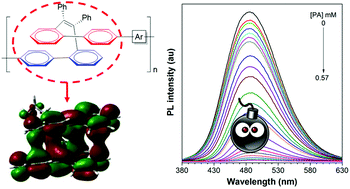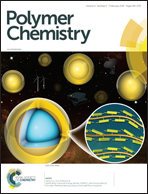New fluorescent through-space conjugated polymers: synthesis, optical properties and explosive detection†
Abstract
Through-bond conjugated polymers have been widely studied and shown great potential in various applications due to their conductive or luminescence properties, while through-space conjugated polymers are less explored. In this work, a unique through-space conjugated monomer derived from folded tetraphenylethene (TPE) is utilized to build a series of new polymers by Pd-catalyzed Suzuki or Stille coupling reactions. The new polymers are well characterized, and their optical and thermal properties and potential application in explosive detection are investigated. All the polymers show good thermal stability with high decomposition temperatures (340–436 °C). They exhibit higher fluorescence quantum yields in aggregates and films than in solutions, namely they show aggregation-enhanced emission (AEE) properties. They perform well in explosive detection in aqueous media using picric acid as a model. The nanoaggregates of the polymers show high quenching constants of up to 552 000 M−1, which is much higher than those in THF solution (78 200 M−1), demonstrating the superamplification effect of the polymer nanoaggregates in aqueous media. These new through-space conjugated polymers could be new kinds of fluorescent materials and worth further exploration.



 Please wait while we load your content...
Please wait while we load your content...